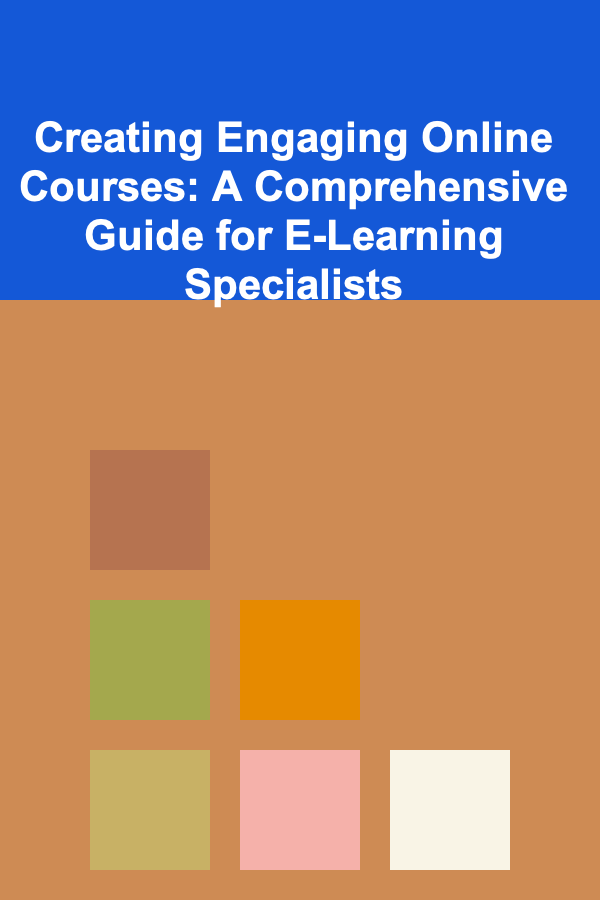
Creating Engaging Online Courses: A Comprehensive Guide for E-Learning Specialists
ebook include PDF & Audio bundle (Micro Guide)
$12.99$8.99
Limited Time Offer! Order within the next:

As the world increasingly shifts toward online learning, creating an engaging and effective online course has become an essential skill for e-learning specialists. Whether you're designing a course for academic purposes, professional development, or for niche skills, the challenge is to engage learners and deliver content in a way that keeps them motivated and leads to tangible outcomes.
This guide will walk you through the process of creating an online course that not only educates but also captivates your learners. From understanding your audience to incorporating the latest technology and engagement strategies, this comprehensive approach is designed to ensure the success of your course.
Understand Your Learners
Before diving into content creation, it's critical to understand the needs, motivations, and expectations of your learners. An effective online course is built on the foundation of a deep understanding of who your learners are and how they learn best.
Define Your Audience
Start by identifying who your course is for. Are they beginners, intermediate learners, or advanced professionals? What are their common challenges, goals, and pain points? For instance, a course designed for corporate professionals might focus more on practical skills and time efficiency, while one aimed at hobbyists might need to emphasize creativity and enjoyment.
Learner Profiles
Create learner personas that represent typical students in your course. These personas can include details such as:
- Demographics: Age, location, and educational background
- Learning preferences: Do they prefer text, video, or interactive activities?
- Goals and motivations: Are they learning for career advancement, personal growth, or another reason?
- Pain points: What challenges do they face that your course can help solve?
These personas will help you tailor the course content and structure to meet the specific needs of your audience.
Establish Clear Learning Objectives
Every course needs a clear purpose. What do you want learners to achieve by the end of your course? Setting well-defined learning objectives ensures that your course is purposeful and provides a roadmap for your content.
SMART Goals
When establishing learning objectives, consider the SMART framework:
- Specific: What exactly should the learner know or be able to do by the end of the course?
- Measurable: How will you assess whether the learning objective has been met?
- Achievable: Is the objective realistic within the scope of the course?
- Relevant: Does it align with your learners' needs and goals?
- Time-bound: Can the objective be achieved within the duration of the course?
For example, a learning objective might be: "By the end of this course, learners will be able to design a website using WordPress, including setting up pages, customizing themes, and implementing plugins."
Break Down Objectives
Large objectives can be overwhelming, so break them down into smaller, manageable chunks. This helps learners progress in steps, reinforcing their knowledge and boosting confidence along the way.
Design Engaging Content
Content is the heart of any online course, and the way you present it is just as important as the information itself. A well-designed course combines educational theory with engaging presentation techniques to hold the learner's attention.
Use a Variety of Content Types
People learn in different ways. By incorporating a mix of content types, you can cater to various learning styles and keep students engaged.
- Text-based content: Well-organized written material (articles, guides, and summaries) is great for in-depth explanations.
- Video lessons: Use videos for demonstrations, storytelling, or complex ideas that are easier to understand through visual representation.
- Infographics: These are perfect for summarizing data or presenting a complex concept in an easy-to-understand visual format.
- Podcasts or Audio: Include audio recordings to cater to auditory learners or to provide a different mode of learning.
- Interactive content: Quizzes, polls, and interactive simulations increase engagement and allow learners to test their knowledge.
Chunk Information
Long blocks of text or video can overwhelm learners. Break your content into digestible chunks, or modules, each focusing on a specific topic or concept. This "chunking" method is easier for learners to process and retain.
Use Storytelling and Real-Life Examples
Incorporate storytelling into your course. People remember stories better than abstract information. Share case studies, real-life examples, and scenarios that are relevant to your learners' goals. This helps them see how they can apply the knowledge in their own lives or careers.
Engage Learners with Active Learning Strategies
Passive learning, such as simply watching videos or reading, can quickly lead to disengagement. To create a truly engaging learning experience, incorporate active learning strategies that encourage participation and interaction.
Gamification
Gamification is a powerful way to motivate learners by introducing elements of game design, such as points, levels, and badges. Reward students for completing modules, engaging in discussions, or achieving high scores on quizzes. Not only does this make learning more fun, but it also promotes a sense of achievement.
Interactive Quizzes and Assessments
Quizzes are an excellent way to assess knowledge and keep learners engaged. Include quizzes at the end of each module or section to test understanding and reinforce learning. Provide instant feedback on quiz answers to help learners grasp concepts immediately.
Peer Interaction
Encourage collaboration and discussion among learners. Creating opportunities for peer-to-peer interaction through forums, discussion boards, or group projects fosters a sense of community and can lead to a deeper understanding of the content.
Hands-On Projects
For courses in areas like coding, design, or marketing, provide practical assignments that require learners to apply what they've learned. Hands-on projects allow students to build real-world skills and gain a sense of accomplishment.
Optimize for Accessibility and Usability
An engaging online course is also one that is accessible to a wide range of learners. Accessibility and usability should be integrated into every stage of the course design process to ensure that all learners can participate fully.
Ensure Mobile Compatibility
Many learners access courses from mobile devices. Ensure that your course is optimized for mobile viewing, with clear fonts, easily clickable buttons, and videos that are responsive on smaller screens.
Provide Multiple Navigation Options
Make your course easy to navigate. Provide learners with clear menus, intuitive progress indicators, and options to skip or revisit sections. This helps reduce frustration and makes it easier for learners to follow along.
Consider Learning Disabilities
Incorporate accessibility features such as captions for videos, alternative text for images, and color contrast that is friendly for colorblind learners. It's important to ensure that your course meets the needs of learners with disabilities.
Incorporate Feedback and Iteration
The learning process doesn't end when the course is launched. To create a truly effective course, you must be open to feedback and be willing to improve the course over time.
Collect Learner Feedback
At the end of each module or course, request feedback from learners about what they found useful, what could be improved, and what could make the learning experience better. Surveys and anonymous feedback forms work well for this.
Analyze Course Data
If your course platform provides analytics, make use of them. Look at completion rates, quiz scores, and engagement statistics to understand which parts of your course are most effective and which may need improvement.
Update and Improve
Based on the feedback and data you collect, continue refining and updating the course. Regular updates ensure that your content stays relevant and engaging, and it also shows learners that you are committed to providing the best learning experience possible.
Market Your Course
Even the best course needs promotion to reach a wider audience. As an e-learning specialist, you'll need to effectively market your course to ensure it attracts learners.
Build a Landing Page
Create a compelling landing page for your course that clearly communicates its benefits, objectives, and outcomes. Use strong calls to action and testimonials to encourage potential students to enroll.
Utilize Social Media and Email Marketing
Promote your course on social media platforms, relevant forums, and through email campaigns. Engaging with communities that align with your course topic can help you reach the right audience.
Offer Free Samples
Offering free preview lessons or a free mini-course is a great way to give potential learners a taste of what they can expect. It can help them make an informed decision about whether the full course is right for them.
Conclusion
Creating an engaging online course requires more than just delivering information. It's about creating an experience that motivates learners, meets their needs, and helps them achieve real outcomes. By understanding your audience, establishing clear learning objectives, designing interactive and engaging content, and incorporating feedback for continuous improvement, you can build courses that are not only informative but also deeply impactful.
As you continue to refine your course design and stay updated with emerging trends in the e-learning space, you'll be better positioned to create truly transformative learning experiences. The future of education is online, and with the right approach, your courses can make a lasting impact.

How to Develop a Money Mindset for Abundance
Read More
How to Focus on Customer Service During Your Yard Sale
Read More
How to Make Your Guest Room Holiday-Ready for Visitors
Read More
How to Store Shoes Effectively in a Small Space
Read More
How to Use Curtains to Soundproof Your Home Effectively
Read More
Quick and Affordable Cheap and Healthy Meal Ideas for Every Family
Read MoreOther Products

How to Develop a Money Mindset for Abundance
Read More
How to Focus on Customer Service During Your Yard Sale
Read More
How to Make Your Guest Room Holiday-Ready for Visitors
Read More
How to Store Shoes Effectively in a Small Space
Read More
How to Use Curtains to Soundproof Your Home Effectively
Read More